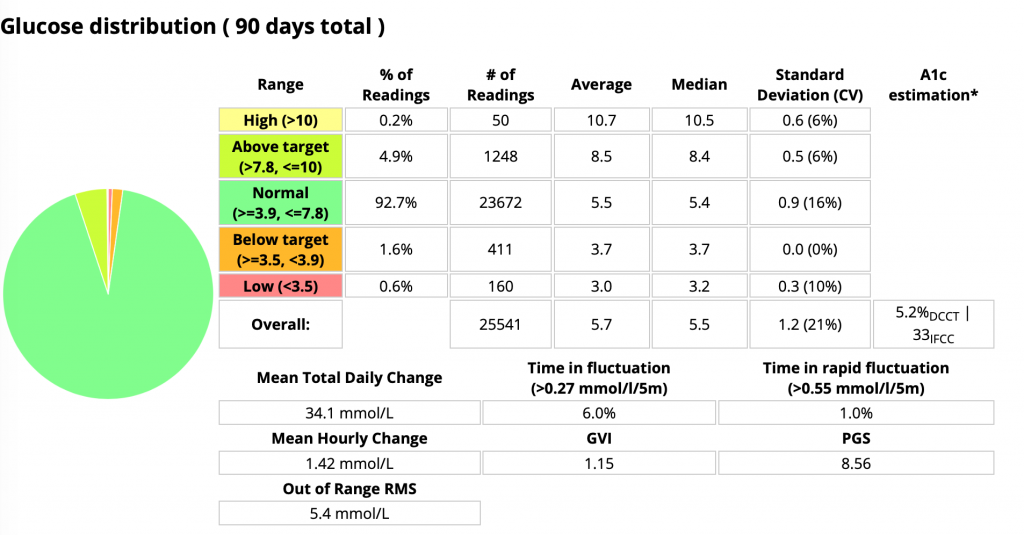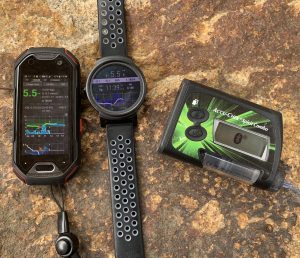Living should be about having a fulfilling life. Living with diabetes does add a lot of things to life including dealing with a lot of numbers. Visualising those numbers in graphs does help make sense of them rather than just seeing a sea of digits.
And now it’s time for a little celebration!
As well as the continual monitoring and tweaking through things like my CGM, I get bloods taken several times a year to check that everything’s hopefully in balance. Today I received the latest set of blood results, and it’s gratifying to see that they correlate with the CGM data!

For the standard clinical reporting range of 3.9-10 mmol/L (70-180 mg/dL) those numbers add up to a Time In Range of 97.6%!
Something left for me to work on is to reduce the 2.2% of time I’ve spent below 3.9 mmol/L. Mind you, some of that has been CGM errors such as compression lows. I’ll see what’s happened to those numbers next year.
Incidentally, for any data nerds who care about Dexcom’s “PGS” number, the value above is being calculated for the 3.9-7.8 mmol/L range which is my usual target. For 3.9-10 the PGS comes to 2.82.
Tech
 Technology-wise, the equipment I’m using includes:
Technology-wise, the equipment I’m using includes:
- an Accu-Chek Combo insulin pump,
- Fiasp insulin,
- Dexcom G5 CGM, and
- the AndroidAPS software tying it all together into a closed-loop system.
Unlike the only commercial closed-loop system available in Australia (which targets a BG of 6.7 mmol/L) I have been able to average 5.7 mmol/L over the last 90 days. Although my system does target 5.2, it would be unusual for any of these systems to always meet the target precisely.
This has helped me achieve results that many doctors have referred to as “normoglycaemic”, “euglycaemic”, or “non-diabetic”.

As you can see in this 90-day graph (and in the numbers above) this technology has helped me achieve a tight range with little variation, without significant hypoglycaemic events.
Another difference from the commercial closed-loop system is that I don’t continually get interrupted by it. I calibrate every now and then (and if the calibrations don’t seem to be working I can quickly reset the calibrations and continue with new ones). My loop system runs in the background of my life while I get on with things.
Lab result
This resulted in an HbA1c number of 33 mmol/mol (5.2%). The lab blood test taken this week came up with the same number as the CGM estimate seen above.

Apparently the standard reference range for someone without diabetes is 25-38 (4.4-5.6%), and all my medical team seem very impressed! I have heard from other people of doctors who would regard these HbA1c results as “too low for a diabetic”. But given the CGM data, I have not heard any of that push-back from my doctors (including a GP I met for the first time today in a consult).
Low-carb?
Some people will look at my data and assume I’m a very-low-carb diet enthusiast. Far from it!
I enjoy my beer, cider, G&T, chocolate, ice cream, etc, etc. But I eat them in moderation. Having coeliac disease as well as T1D does eliminate some food choices for me, but I manage.
I do try to limit my carb intake especially when exercising (I have been doing a lot of riding to/from work lately) but overall my average carb intake is 150-200 g/day. That’s a lot less than I used to eat years ago, but it’s not really in the “Bernstein” category.
Lucky
I know I’m lucky. I’ve had Type 1 Diabetes for over 37 years so far, and it’s only within the last 3 years that I’ve had access to these tools and been able to bring my glucose numbers back towards “euglycaemia”.
My HbA1c has been close to or within the reference range for the last 2 years. It’s taken a while: tweaking the system along the way, with continual improvements. I look forward to access to CGM being improved for everyone, as that’s the key that allows all this to be possible.
Life is very busy. Luckily the diabetes numbers rarely get in the way!


Fantastic!!!!! I am one who was told my relatively low HbA1c is not favoured … not as amazing as yours but not bad at 5.7 for mdi (no pump) and almost 53 years t1D. But this last time of HbA1c under 6 the Diab Nurse practitioner was not so concerned as I had my cgm results to support that there were not many dangerous lows. I too love numbers and graphs (ex Maths Science teacher)… it helps being analytical. I attend carefully to slight changes in the gradient of the graph… not just the arrows on the cgm. I am really impressed with your tech skills and results and would love your system but even with what I have things are so much better than 50 years ago…. better insulins, and importantly I self fund cgm (would love Fiasp to get the occasional stubborn high down more quickly but have not found anyone to write a script… gp has never heard of it!)
Finally… CONGRATULATIONS!!!
Awesome David I was 5.8% on the Dr Bernstein low carb diet. but both my DE and Endo said it was too low for my age (66). Should be 6.8% . I would like to try Looping but I am on a Medtronic 670G and Guardian 3 CGM and most say it won’t work.
Indeed, it’s not possible to link the 670G into an external loop controller, only to use it with Medtronic’s internal auto mode algorithm. Or use it as a “manual pump”.
I selected my Combo back in 2017 specifically because it would be loopable.
BTW I do know people older than you who are looping with the knowledge of their medical teams, so it’s possible. But I don’t know the details of what levels they have their systems tuned to.
David, how can this range be expanded in Nightscout with more options, such as “Above target” and “Below target” and in certain colors, however, I cannot find which codes I should put in Heroku. Can you please tell me how?
It’s development code which isn’t in the main Nightscout code yet. Hopefully soon.